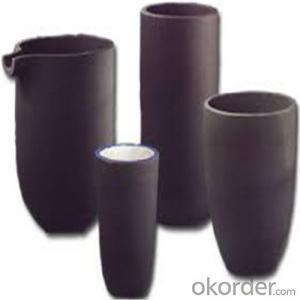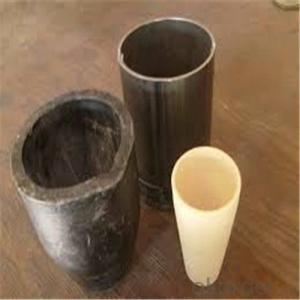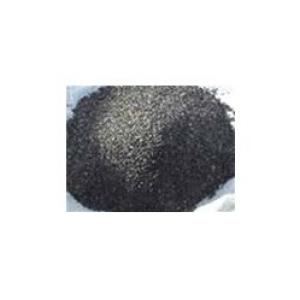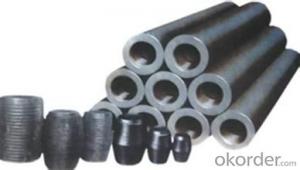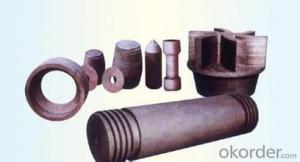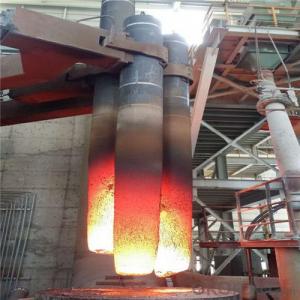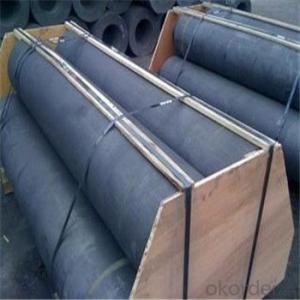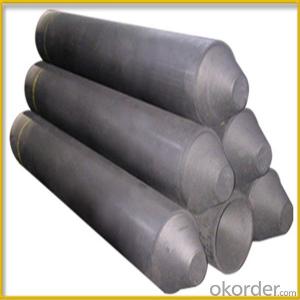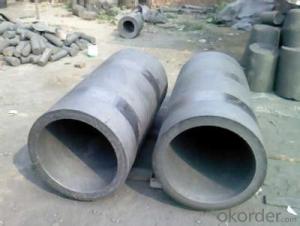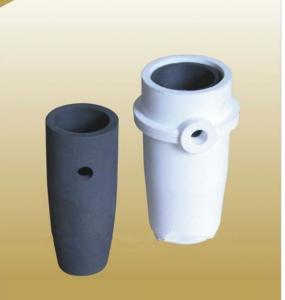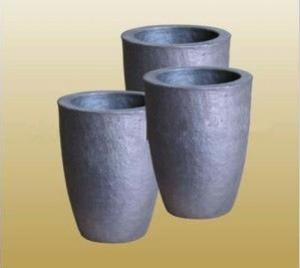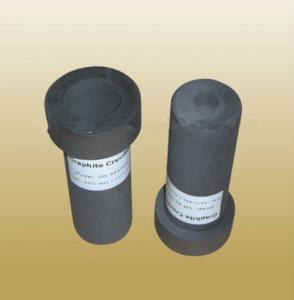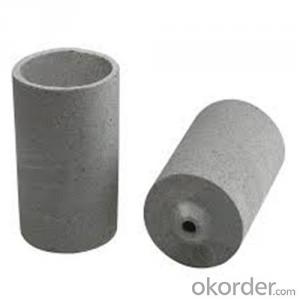Clay Graphite Crucible,SiC Crucibles For Melting Aluminium And Copper, Brass
- Loading Port:
- Shanghai
- Payment Terms:
- TT OR LC
- Min Order Qty:
- 1 pc
- Supply Capability:
- 1000 pc/month
OKorder Service Pledge
OKorder Financial Service
You Might Also Like
Quick Details for SiC Graphite Crucibles
| Type: | High Strength, graphite crucible crucible | Application: | melting metal | Height: | as your requirements |
| Composition: | High Pure | Top Diameter: | 10-600mm | Bottom Diameter: | 10-1000mm |
| Place of Origin: | China (Mainland) | Brand Name: | Model Number: | ||
| Color: | Black grey | Si3N4%: | 5min | Fe2O3%: | 0.7max |
| C%: | 30-45 | Apparent porosity: | 30max | Refractoriness: | 1680 |
| Bulk Density: | 1.71min | Using life: | >5000 hours | MAX temperature: | 1600c |
Packaging & Delivery
| Packaging Details: | Seaworty packing or as per customer's detail requirement of graphite crucible. |
| Delivery Detail: | within 20-30 days after confirm order of graphite cru |
SiC Graphite Crucibles For Melting Aluminium And Copper, Brass
Product Description
Specifications for Graphite Silicon Carbide Crucible For Aluminum Melting :
1.Long working lifetime: its working lifetime is increased 3-5 times over normal clay-crucible due to the compact body formed under high pressure.
2.High thermal conductivity: high-density body and low apparent porosity greatly improve its heat conductivity.
3.New-style materials: new heat conduction material ensures faster heat conductivity and pollution-free product, reduces adherent slag.
4.Resistance to corrosion:better anti-corrosion than normal clay-crucible.
5.Resistance to oxidation: advanced process dramatically improves its oxidation resistance, which ensures persistent heat conductivity and long working lifetime.
6.High-strength: high-density body and logical structure make the product better compression property.
7.Eco-friendly: energy-efficient and pollution-free, not only ensure metal product purity, but also ensure sustainable development on environment.
8.Multi-function: Can be used in induction graphite crucible furnace
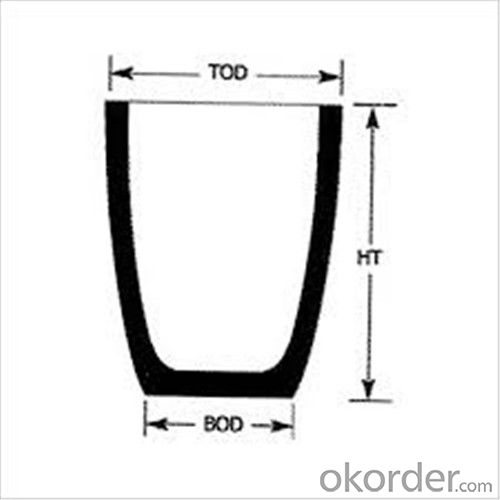

Physicochemical Properties
Type of Crucible | Type S | Type D |
Carbon Content/% | ≥38 | ≥45 |
Bulk Density/(g/cm3) | ≥1.70 | ≥1.85 |
Apparent Porosity/% | ≤29 | ≤21 |
Compression Strength/MPa | ≥20 | ≥25 |
Refractoriness/°C | ≥1400 | ≥1400 |
Type S: Clay graphite crucible
Type D: Isostatic pressing graphite crucible
Cited from CNS China National Standard of Graphite Crucible, which is solely drifted by TIANFU company.
Content Composition
C% | Sic% | AL2O3% | SIO2% |
45%-50% | 20%-30% | 10%-12% | 15-25% |
- Q:What can replace a graphite crucible?
- Silicon carbide crucibles can be used instead of graphite crucibles.
- Q:How long can a graphite crucible last?
- The lifespan of a graphite crucible can vary depending on several factors such as the quality of the graphite used, the type of material being melted, the temperature at which it is used, and the care and maintenance practices followed. Generally, a graphite crucible can last for several months to several years. If used for lower temperature applications or with non-reactive materials, it can have a longer lifespan. On the other hand, if used for high-temperature applications or with corrosive materials, the crucible may wear out more quickly. Over time, the repeated heating and cooling cycles, as well as exposure to different chemicals, can cause the graphite crucible to develop cracks, erosion, or other signs of wear. It is important to regularly inspect the crucible for any damage and replace it if necessary to ensure the quality and safety of the melting process. Proper care and maintenance can also extend the lifespan of a graphite crucible. This includes preheating the crucible before use, avoiding thermal shock by gradually heating and cooling the crucible, and cleaning it properly after each use. Using appropriate crucible handling tools and avoiding rough handling can also help avoid unnecessary damage. In conclusion, while there is no exact lifespan for a graphite crucible, it can last for several months to several years depending on various factors. Regular inspection, proper care, and maintenance are crucial in maximizing the lifespan and performance of the crucible.
- Q:How does the thermal shock resistance of graphite affect the performance of a crucible?
- The thermal shock resistance of graphite directly affects the performance of a crucible. A high thermal shock resistance ensures that the crucible can withstand rapid changes in temperature without cracking or breaking. This is crucial in processes that involve extreme temperature fluctuations, such as melting metals or performing thermal analysis. A crucible with low thermal shock resistance may fail under such conditions, leading to contamination, loss of materials, and compromised experimental results. Therefore, the thermal shock resistance of graphite is essential for maintaining the integrity and efficiency of a crucible.
- Q:Can graphite crucibles be used for both melting and casting?
- Yes, graphite crucibles can be used for both melting and casting. Graphite is known for its excellent heat resistance and high melting point, which makes it an ideal material for containing molten metals during the melting process. Additionally, graphite crucibles have good thermal conductivity, allowing for efficient heat transfer and uniform heating of the molten metal. Once the metal is melted, the graphite crucible can also be used for casting. The molten metal can be poured directly from the crucible into a mold, allowing for the creation of various shapes and forms. Graphite crucibles are typically durable and can withstand repeated heating and cooling cycles, making them suitable for both melting and casting processes. However, it is important to note that graphite crucibles may not be suitable for all types of metals. Some reactive or corrosive metals may react with graphite at high temperatures, leading to contamination of the molten metal. In such cases, alternative crucible materials like ceramic or refractory metals may be more appropriate.
- Q:What are the different methods of removing impurities from a graphite crucible?
- There are several methods for removing impurities from a graphite crucible. One common method is to heat the crucible to a high temperature, which causes the impurities to burn off or vaporize. Another method involves soaking the crucible in a chemical solution that can dissolve the impurities. Ultrasonic cleaning is also an effective method, where high-frequency sound waves create vibrations that help dislodge the impurities. Additionally, physical methods like scrubbing or scraping can be used to remove any remaining impurities from the crucible's surface.
- Q:Can graphite crucibles be used for metal casting?
- Metal casting can indeed utilize graphite crucibles. Due to their elevated melting point and exceptional thermal conductivity, graphite is frequently employed as a crucible material in metal casting. It is especially well-suited for casting non-ferrous metals like gold, silver, copper, and aluminum. Graphite crucibles are capable of enduring high temperatures without experiencing cracking or deformation, making them ideal for melting and pouring molten metal. Moreover, graphite exhibits low chemical reactivity, preventing any adverse reactions with the metal being cast. This characteristic ensures the preservation of purity and quality in the final cast metal. However, it should be noted that graphite crucibles may not be suitable for casting certain metals with high melting points, such as steel, as they may not withstand the extreme temperatures required for melting these metals. In such instances, alternative materials such as clay or ceramic crucibles may prove more appropriate.
- Q:What special attention should be paid to the use of graphite crucible in vacuum induction melting of titanium alloy?
- In the smelting of titanium alloy, because there are a lot of active element Ti in the alloy, it is easy to react with C, N, O and other elements, resulting in the change of alloy composition
- Q:Why does the graphite crucible used for molten gold add a quartz coat?
- The melting point of gold is 1063 degrees Celsius. At this temperature, graphite reacts with oxygen in the air to produce carbon dioxide. The quartz coat may be used to prevent leakage of graphite crucibles
- Q:Can graphite crucibles be used for rapid thermal cycling?
- Yes, graphite crucibles can be used for rapid thermal cycling. Graphite has excellent thermal conductivity and high heat resistance, making it suitable for rapid temperature changes. This means that graphite crucibles can withstand the rapid heating and cooling required for thermal cycling processes. Additionally, graphite has a low coefficient of thermal expansion, which means it has minimal dimensional changes during temperature variations, making it ideal for repetitive thermal cycling.
- Q:Can a graphite crucible be used for melting food-grade substances?
- No, a graphite crucible should not be used for melting food-grade substances as graphite can react with the food and contaminate it. It is important to use food-grade materials specifically designed for heating and melting food substances.
1. Manufacturer Overview |
|
|---|---|
| Location | |
| Year Established | |
| Annual Output Value | |
| Main Markets | |
| Company Certifications | |
2. Manufacturer Certificates |
|
|---|---|
| a) Certification Name | |
| Range | |
| Reference | |
| Validity Period | |
3. Manufacturer Capability |
|
|---|---|
| a)Trade Capacity | |
| Nearest Port | |
| Export Percentage | |
| No.of Employees in Trade Department | |
| Language Spoken: | |
| b)Factory Information | |
| Factory Size: | |
| No. of Production Lines | |
| Contract Manufacturing | |
| Product Price Range | |
Send your message to us
Clay Graphite Crucible,SiC Crucibles For Melting Aluminium And Copper, Brass
- Loading Port:
- Shanghai
- Payment Terms:
- TT OR LC
- Min Order Qty:
- 1 pc
- Supply Capability:
- 1000 pc/month
OKorder Service Pledge
OKorder Financial Service
Similar products
New products
Hot products
Hot Searches
Related keywords
